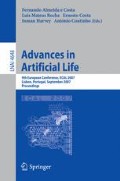Abstract
In previous work [4] a framework was demonstrated that allows an autonomous robot to automatically synthesize physically-realistic models of its own body. Here it is demonstrated how the same approach can be applied to empower a robot to synthesize physically-realistic models of its surroundings. Robots which build numerical or other non-physical models of their environments are limited in the kinds of predictions they can make about the repercussions of future actions. In this paper it is shown that a robot equipped with a self-made, physically-realistic model can extrapolate: a slow-moving robot consistently predicts the much faster top speed at which it can safely drive across a terrain.
Access this chapter
Tax calculation will be finalised at checkout
Purchases are for personal use only
Preview
Unable to display preview. Download preview PDF.
References
Arkin, R.C.: Behavior-based Robotics. MIT Press, Cambridge (1998)
Bongard, J., Lipson, H.: Nonlinear system identification using coevolution of models and tests. IEEE Transactions on Evolutionary Computation 9(4), 361–384 (2005)
Bongard, J., Lipson, H.: Automated reverse engineering of nonlinear dynamical systems. Proceedings of the National Academy of Science (to appear, 2007)
Bongard, J., Zykov, V., Lipson, H.: Resilient machines through continuous self-modeling. Science 314, 1118–1121 (2006)
Brooks, R.A.: Intelligence without representation. Artificial Intelligence 47, 139–160 (1991)
Cliff, D., Husbands, P., Harvey, I.: Evolving visually guided robots. In: Meyer, J.-A., Roitblat, H., Wilson, S. (eds.) Proceedings of the Second International Conference on the Simulation of Adaptive Behaviour, MIT Press, Cambridge (1993)
Danforth, C.M., Yorke, J.A.: Making Forecasts for Chaotic Physical Processes. Physical Review Letters 96(14), 144102 (2006)
Floreano, D., Mondada, F.: Hardware solutions for evolutionary robotics. In: Husbands, P., Meyer, J.-A. (eds.) EvoRobots, pp. 137–151 (1998)
Gloye, A., Wiesel, F., Tenchio, O., Simon, M.: Reinforcing the driving quality of soccer playing robots by anticipation. IT - Information Technology 47(5), 250–257 (2005)
Jakobi, N.: Evolutionary robotics and the radical envelope of noise hypothesis. Adaptive Behavior 6(1), 131–174 (1997)
Keymeulen, D., Iwata, M., Kuniyoshi, Y., Higuchi, T.: Online evolution for a self-adapting robotics navigation system using evolvable hardware. Artificial Life 4, 359–393 (1998)
Nilsson, N.: Shakey the Robot. SRI International, Menlo Park (1984)
Nolfi, S., Floreano, D.: Evolutionary Robotics. MIT Press, Boston (2000)
Pollack, J.B., Lipson, H., Ficici, S., Funes, P., Hornby, G., Watson, R.: Evolutionary techniques in physical robotics. In: Miller, J.F., Thompson, A., Thompson, P., Fogarty, T.C. (eds.) ICES 2000. LNCS, vol. 1801, pp. 175–186. Springer, Heidelberg (2000)
Russell, S.J., Norvig, P.: Artificial Intelligence: A Modern Approach. Prentice-Hall, Upper Saddle River (1995)
Strogatz, S.H.: Nonlinear Dynamics and Chaos: with applications to physics, biology, chemistry, and engineering. Perseus Books, Reading (1994)
Tedrake, R., Zhang, T., Seung, H.: Learning to walk in 20 minutes. In: Proceedings of the Fourteenth Yale Workshop on Adaptive and Learning Systems. Yale University, New Haven, CT (2005)
Thrun, S., Burgard, W., Fox, D.: Probabilistic Robotics. MIT Press, Cambridge (2005)
Author information
Authors and Affiliations
Editor information
Rights and permissions
Copyright information
© 2007 Springer-Verlag Berlin Heidelberg
About this paper
Cite this paper
Bongard, J. (2007). Synthesizing Physically-Realistic Environmental Models from Robot Exploration. In: Almeida e Costa, F., Rocha, L.M., Costa, E., Harvey, I., Coutinho, A. (eds) Advances in Artificial Life. ECAL 2007. Lecture Notes in Computer Science(), vol 4648. Springer, Berlin, Heidelberg. https://doi.org/10.1007/978-3-540-74913-4_81
Download citation
DOI: https://doi.org/10.1007/978-3-540-74913-4_81
Publisher Name: Springer, Berlin, Heidelberg
Print ISBN: 978-3-540-74912-7
Online ISBN: 978-3-540-74913-4
eBook Packages: Computer ScienceComputer Science (R0)

